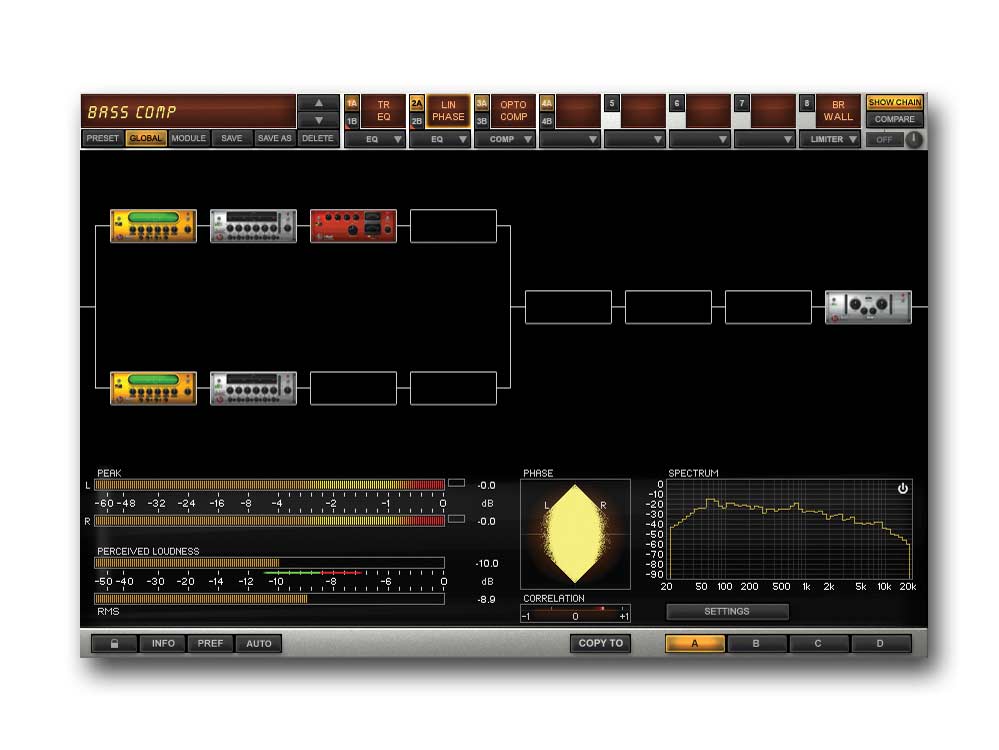MusicRadar Verdict
A few curious omissions hold T-RackS 3 back from true greatness, but there's no denying that it sounds the business.
Pros
- +
Audio quality is excellent. Emulations add some analogue 'magic'. Very easy to get good results. A/B/C/D compare function.
Cons
- -
Eats CPU like a T-Rex! No dedicated stereo-imaging module. Multiband Limiter could be better. Interface has some shortfalls.
MusicRadar's got your back

T-RackS 3

T-rackS 3
T-RackS 3 can run as a plug-in suite inside your DAW, but you can't load individual processors as single VST plug-ins (as you could with older versions). It uses a 'shell' system, a bit like IK's AmpliTube range.
The software also works as a standalone audio mastering solution, which differs only in that it has a simple audio editor for adding fades and automated mastering changes, and lets you render out to audio files.
If you buy the Classic version of T-RackS 3, you get the same four processors as the original, albeit in spruced-up form. These are the Equalizer, Compressor, Multiband Limiter and Clipper. They're functionally identical to previous releases, but have apparently undergone an audio path update to bring them up to v3's standards.
The real excitement, though, concerns the Deluxe edition, which we're focusing on here. This boasts five additional, brand-new processors.
There are three new 'analogue' modules: the Vintage Tube Compressor, Vintage Tube Program Equaliser and Opto Compressor. These are based on the legendary Fairchild 670 tube compressor, the similarly illustrious Pultec EQP-1A equaliser, and an unspecified optical compression design respectively.
Rounding things off in thoroughly digital style are the Brickwall Limiter and Linear Phase Equaliser.
In detail
The familiar T-RackS GUI has been overhauled: what was previously a fixed rack of effects is now a more complex and versatile modular affair. You can only see one module at a time in the main window (the interfaces are rather hefty), while the metering section sits at the bottom and is ever-present.
Up top, there are 12 processing slots, arranged as two parallel four-slot chains, followed by a final serial chain of four. This gives plenty of parallel processing potential - using two types of compression at once, or applying frequency-dependent compression/limiting, for example. The new Linear Phase EQ comes in handy for the latter application, helping to avoid phasing issues that can arise with regular EQs.
While you can view the processing chain in schematic format, it's a real disappointment - quite a surprise, in fact - that you can't drag and drop effects to reorder them. IK Multimedia tells us that this functionality will be added in an update.
More well-conceived is the Compare section, which balances the volume of the original and mastered audio. This enables you to make comparisons without being blindsided by differing volume levels. The A/B/C/D compare panel is another winner, enabling you to set up four mastering chains and flip between them instantly.
As for the metering, it's a welcome addition, but it's annoying that you can't switch it off or hide it away, as it's not always useful and takes up a fair bit of screen space. However, it is extremely customisable, with the perceived loudness meter very helpful when trying to maintain a consistent-sounding level.
The stereo phase meter is slightly redundant considering there's no dedicated stereo imaging module. The new EQs and compressors have mid/side modes, though, which can be used to manipulate the stereo image, and the Classic Compressor has a stereo-tweaking function.
IK says that it intends to add further modules in the future - a stereo tool wouldn't go amiss.
Sound
Putting T-RackS through its paces, the new 'analogue' plug-ins impressed us most, bringing some of that elusive warm and punchy magic to your tracks. The Fairchild and Pultec emulations are comparable to those of Universal Audio's renowned UAD system, which is to say that they're very good indeed.
The EQ helps to take the harsh edge off digital-sounding material, while still brightening it up. However, our favourite is the Opto Compressor, which is blessed with a fantastic sound that makes it a contender for 'best native software compressor'.
The Brickwall Limiter has numerous modes, offering different 'flavours' of limiting. It's great for making mixes louder than they've any right to be, though it's not as transparent as, say, PSP Xenon. The Linear Phase EQ offers exactly what you'd expect: equalisation without colouration.
In the highest-quality mode, with linear phase operation and oversampling engaged, T-RackS 3 can be very CPU hungry. This is fine for mastering, but if you're using T-RackS 3 for mixing, you'll want to enable the Lowest Latency mode, which disables the CPU-guzzling oversampling, although it's still no lightweight.
Summary
Both the Deluxe and Classic T-RackS 3 bundles represent solid value for money. You can achieve great mastering results with minimal fuss, and the processors work well in the mix, too.
That said, some of the interface issues - such as the inability to reorder effects or hide meters - are frustrating and take the edge off things, so we'll certainly be looking forward to those updates.
Computer Music magazine is the world’s best selling publication dedicated solely to making great music with your Mac or PC computer. Each issue it brings its lucky readers the best in cutting-edge tutorials, need-to-know, expert software reviews and even all the tools you actually need to make great music today, courtesy of our legendary CM Plugin Suite.
“A synthesizer that is both easy to use and fun to play whilst maintaining a decent degree of programming depth and flexibility”: PWM Mantis review
“I feel like that song had everything we needed to come back with”: Bring Me The Horizon’s Lee Malia on Shadow Moses, its riff and the secrets behind its tone, and why it was the right anthem at the right time
“I said, ‘Are we sure we can write a song about death?’”: The story of Mike + The Mechanics' classic No.1 The Living Years










